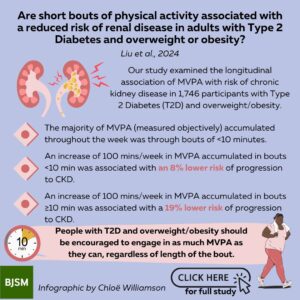Authors: Mengyi Liu and Xianhui Qin
Why is this study important?
Evidence regarding the association between physical activity (PA) and the risk chronic kidney diseases (CKD) in participants with Type 2 Diabetes (T2D) is generally limited due to the use of self-report questionnaires. Moreover, although the 2008 Physical Activity Guidelines for Americans recommend accumulating ≥150 min/week moderate to vigorous PA (MVPA) in bouts lasting ≥10 min, the 10-min bout statement has recently been removed in the US and World Health Organization (WHO) guidelines. This is important as most free-living and unstructured MVPA activity is likely performed in episodes typically <10 minutes in duration, and bouts of PA <10 minutes in duration may also have health-related benefits. Nevertheless, little is known about the renal health benefits of MVPA in short episodes lasting <10 min.
How did the study go about this?
To address the above important knowledge gap, we aimed to examine the longitudinal association of objectively measured MVPA and changes in MVPA with the risk of progression to CKD in 1,746 participants with T2D and overweight/obesity who had baseline estimated glomerular filtration rate (eGFR) of ≥60 ml/min/1.73 m2 in the Look AHEAD trial. We also evaluated whether the association varied when PA was considered in short (<10 min) and long (≥10 min) bouts. MVPA was measured at baseline, year 1, year 4, and year 8 using an RT3 accelerometer.
What did the study find?
Drawing on data from 1,746 participants, the median time spent in total MVPA, MVPA accumulated in bouts of <10 min, and MVPA accumulated in bouts of ≥10 min was 328.8, 266.8, and 40.6 min/week, respectively. This means that the majority of MVPA occurred in bouts <10 min.
Overall, there was a linear association of MVPA with progression to CKD. An increase of 100 minutes per week in total MVPA was associated with a 9% lower risk of progression to CKD. An increase of 100 minutes per week in MVPA accumulated in bouts <10 min was associated with an 8% lower risk of progression to CKD. An increase of 100 minutes per week in MVPA accumulated in bouts ≥10 min was associated with a 19% lower risk of progression to CKD.
Moreover, 783 (63.3%) participants had a reduction in MVPA time from baseline to year 4. Compared with the largest MVPA reduction, an increase in total MVPA was associated with a 33% lower risk of progression to CKD, and an increase in MVPA accumulated in bouts of both <10 min and ≥10 min was associated with a 33% and 29% lower risk of progression to CKD, respectively.
What are the key take-home points?
Our results suggest that people with T2D and overweight/obesity should be encouraged to engage in as much MVPA as they can tolerate to maximize the benefits, regardless of length of the bout, while supporting recent changes in the US and WHO guidelines that have removed the suggestion that MVPA should be accumulated in bouts of at least 10 minutes.
Our study has important public health implications because it suggests that maintaining a high level of MVPA, regardless of length of the bout, may have renal benefit for adults with overweight/obesity and T2D. This is especially important for PA promotion in individuals who are unwilling or unable to engage in PA bouts that are ≥10 minutes in duration.
